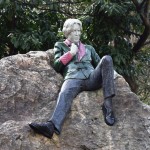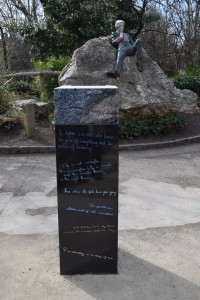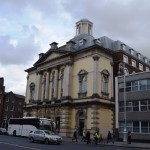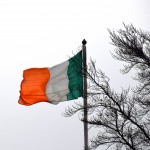 I’m writing this from Dublin where I’m attending some of the events celebrating 100 years since the Easter Rising. The Rising has a complicated legacy–too much so to enter into here. We’ll explore some of this during our trip. But over the years, the nature of the commemorations of the “insurrection” tells us a lot about Ireland’s transformation during this time. Initially, the Rising was commemorated mainly as as a military event. Those who served and died in 1916 were accorded almost saintlike stature, their families and descendants honored accordingly and given considerable say in what happened during the celebrations, Politics played a huge role, and the party in power determined how the ceremonies went, who sat where, and how the story of the Rising was told. A narrow definition of the Rising and of what it means to be Irish prevailed. The fiftieth anniversary opened things up a bit, with the then Taioseach (prime minister) Seán Lemass (one of my heroes) using the occasion to portray Ireland as a modern, progressive nation leading the way to European unification, excelling at industry, and moving towards rapprochement with Northern Ireland. During the Troubles in Northern Ireland (1968-1998), the military aspect of the commemorations was toned down for fear of inciting further violence. The signing of the Good Friday Peace Agreement and its ratification in Northern Ireland and in the Republic of Ireland in 1998 made it possible to take a fresh look at the past.
I’m writing this from Dublin where I’m attending some of the events celebrating 100 years since the Easter Rising. The Rising has a complicated legacy–too much so to enter into here. We’ll explore some of this during our trip. But over the years, the nature of the commemorations of the “insurrection” tells us a lot about Ireland’s transformation during this time. Initially, the Rising was commemorated mainly as as a military event. Those who served and died in 1916 were accorded almost saintlike stature, their families and descendants honored accordingly and given considerable say in what happened during the celebrations, Politics played a huge role, and the party in power determined how the ceremonies went, who sat where, and how the story of the Rising was told. A narrow definition of the Rising and of what it means to be Irish prevailed. The fiftieth anniversary opened things up a bit, with the then Taioseach (prime minister) Seán Lemass (one of my heroes) using the occasion to portray Ireland as a modern, progressive nation leading the way to European unification, excelling at industry, and moving towards rapprochement with Northern Ireland. During the Troubles in Northern Ireland (1968-1998), the military aspect of the commemorations was toned down for fear of inciting further violence. The signing of the Good Friday Peace Agreement and its ratification in Northern Ireland and in the Republic of Ireland in 1998 made it possible to take a fresh look at the past.
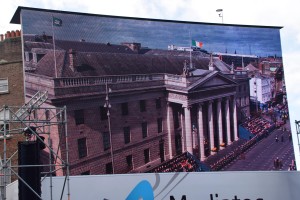
Only in the last several decades have historians begun to question and debate everything about the Rising and to challenge the party line. An absolute flood of scholarship, books, films, exhibits, and more has, in the words of historian Diarmaid Ferriter, “complicated the story” of the Eastern Rising–and rightly so. Such a momentous event deserves nothing less. This weekend’s festivities were marked by a step back from politicization, a welcoming of debate, and the embrace of language celebrating diversity and inclusion. Here are the words spoken by Fr. Séamus Madigan at the General Post Office commemoration today.
Look kindly we pray, on the people of Ireland, from all traditions, at home and abroad. Help us listen and respond to the voices that challenge in 2016 as we reimagine our future. Conscious of our troubled past, ‘To you O God, we sing a new song;’ a song of compassion, inclusion and engagement, a song of listening, social justice and respect for all, a song of unity, diversity, equality and peace, a song of Céad Mile Fáilte and of care for our environment. With you O Lord, we long to sing our new song in a spirit of true freedom.

